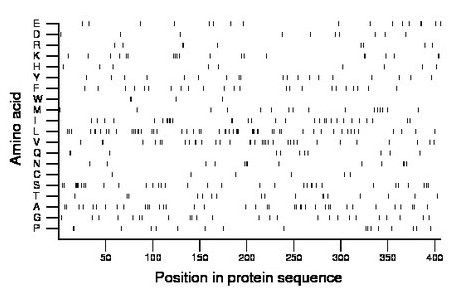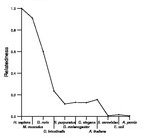
| Name: NIPAL3 | Sequence: fasta or formatted (406aa) | NCBI GI: 10092687 | |
|
Description: NIPA-like domain containing 3
|
Referenced in:
| ||
|
Composition:

Amino acid Percentage Count Longest homopolymer A alanine 9.4 38 2 C cysteine 1.5 6 1 D aspartate 2.5 10 1 E glutamate 4.2 17 2 F phenylalanine 5.7 23 1 G glycine 6.2 25 1 H histidine 2.2 9 1 I isoleucine 7.4 30 2 K lysine 4.9 20 2 L leucine 13.3 54 3 M methionine 3.9 16 1 N asparagine 3.2 13 2 P proline 4.2 17 2 Q glutamine 2.7 11 2 R arginine 2.2 9 2 S serine 8.4 34 4 T threonine 4.2 17 2 V valine 8.4 34 2 W tryptophan 1.0 4 2 Y tyrosine 4.7 19 1 |
Comparative genomics:
Search single species RefSeq proteins at NCBI
Search summary 
Figure data | ||
Related human proteins:Protein Relative score Description Self-match 1.000 NIPA-like domain containing 3 NIPAL2 0.369 NIPA-like domain containing 2 NIPAL1 0.130 NIPA-like domain containing 1 NIPAL4 0.130 ichthyin protein NIPA2 0.123 non imprinted in Prader-Willi/Angelman syndrome 2 is... NIPA2 0.123 non imprinted in Prader-Willi/Angelman syndrome 2 is... NIPA2 0.123 non imprinted in Prader-Willi/Angelman syndrome 2 is... NIPA1 0.106 non-imprinted in Prader-Willi/Angelman syndrome 1 is... NIPA2 0.100 non imprinted in Prader-Willi/Angelman syndrome 2 is... NIPA1 0.089 non-imprinted in Prader-Willi/Angelman syndrome 1 i... GPR128 0.009 G protein-coupled receptor 128 MS4A8B 0.009 membrane-spanning 4-domains, subfamily A, member 8B ... MPDU1 0.006 mannose-P-dolichol utilization defect 1 ITPR3 0.006 inositol 1,4,5-triphosphate receptor, type 3 SLC46A2 0.005 solute carrier family 46, member 2 RNF145 0.005 ring finger protein 145 KCNQ4 0.005 potassium voltage-gated channel KQT-like protein 4 i... KCNQ4 0.005 potassium voltage-gated channel KQT-like protein 4 i... SLC17A4 0.005 solute carrier family 17 (sodium phosphate), member 4...Human BLASTP results (used to prepare the table) | |||
Gene descriptions are from NCBI RefSeq. Search results were obtained with NCBI BLAST and RefSeq entries. When identical proteins are present, the self-match may not be listed first in BLASTP output. In such cases, the table above has been reordered to place it first.
See About the Figures for the scoring system used in the figure above right. The same scoring system was used in the table of BLASTP results.
Guide to the Human Genome
Copyright © 2010 by Stewart Scherer. All rights reserved.
